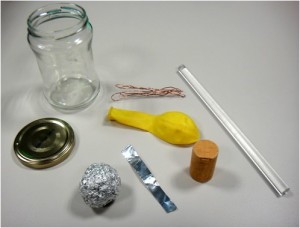Electrical energy or electricity is a physical phenomenon that originates from electrical charges and the interaction between them. Thus, electrons and protons are the two main subatomic particles that can cause the appearance of electrical energy.
The branch that studies the interaction of electric charges when they are at rest is called static electricity, and in this blog we have proposed a series of experiments related to it, such as the study of electric charges, the triboelectric effect or the electrostatic motor.
Today we will focus on the construction of an instrument that allows us to know if a body is electrically charged, and how much: the electroscope.
We suggest that you build this instrument and experiment with as many materials as possible to see what happens in each case and thus understand the phenomena related to the operating principle of the electroscope.
What do we need to build an electroscope?
The materials to carry out this experiment in class are really accessible:
- A wide-mouthed glass jar with a plastic lid.
- A thick wire.
- Foil.
- A cork stopper.
- Different materials, such as a balloon, paper, wool, Teflon, glass…
How is an electroscope built?
To start we need to make a hole in the lid of the jar, the size of the cork stopper. Thus, the cork will be well fitted and the interior of the jar isolated. Once it has been verified that it is well insulated, we will open the jar and work with the cork and the lid.
Subsequently, we will pass the wire through the cork, giving the end of the wire that would remain inside the bottle a hook shape.
Next, with a large piece of aluminum foil, we will make a ball, which we will nail into the straight end of the wire. Also, with another small piece of aluminum foil we will make a strip of approximately 1 cm wide and 10 cm long and we will fold it in half, hanging it on the hook.
Finally, we can now close the can, so that the aluminum ball is on the outside and the hook with the straps on the inside. We already have our electroscope ready to make it work.
How do you experiment with the electroscope and how do we explain it?
Initially, the electroscope is neutrally charged: the positive and negative charges are evenly distributed throughout the assembly. It is for this reason that the sheets of aluminum foil are attached.
It is time to check the electrical charge of different materials.
For example, we can inflate a balloon and rub it to charge it electrically. By touching the aluminum ball of the electroscope with the balloon, we will see how the two sheets of the electroscope will separate from each other.
What happened to the electroscope? The negative charges that had accumulated on the surface of the balloon have moved towards the conductive material, made up of the aluminum ball, the wire and the sheets. Thus, the entire assembly is electrically charged like the balloon. And since the two ends of the sheet are charged with the same sign (negative), they repel each other.
If, after this, we touch the electroscope with a conducting body, such as our finger, the charge is lost and the two sheets come together again, the whole being charged again in a neutral way.
If we now rub a glass rod with paper and charge the electroscope, in this case with positive charges due to the material, the aluminum sheets will separate again, just like in the case of the balloon, because they both have the same positive charge.
But if, once positively charged, we rub the balloon again and bring it closer to the aluminum ball without touching it, we can see that the sheets get closer to each other as the balloon gets closer. This is due to the fact that the positive charges that remain in the electroscope feel attracted by the balloon and are conducted towards the aluminum ball, losing the electric charge.
Thus, the distance at which the sheets repel each other indicates the amount of electric charge that the body that has touched the aluminum ball has.





